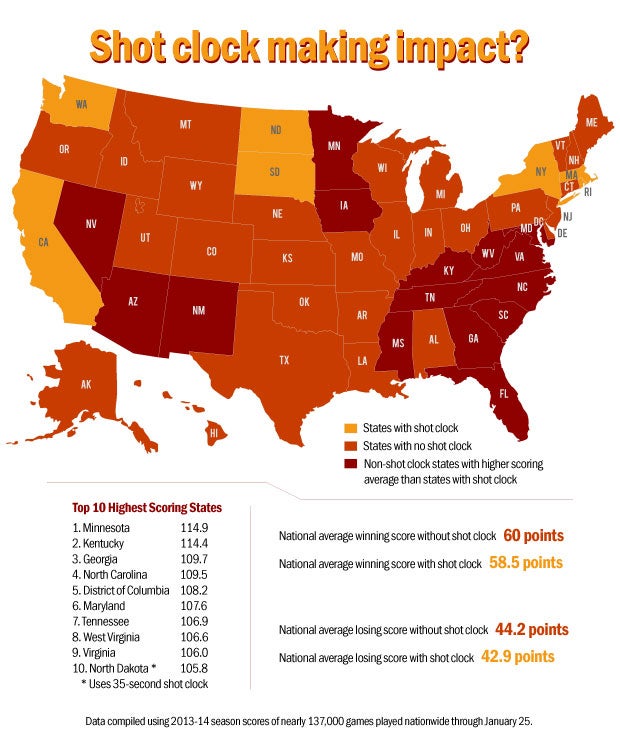
Graphic by Ryan Escobar/Data mined by Dave Smith
Often inspired by the sight of a player standing at halfcourt with ball on hip, the shot clock debate persists in high school basketball.
John Lucas, Paul Biancardi and Dick Vitale of ESPN, and Huntington St. Joseph Prep (W.Va.) head coach Rob Fulford are just a few prominent voices who have voiced support via Twitter for nationwide adoption of the shot clock at the high school level in recent months.The National Federation of State High School Associations (NFHS) voted down a proposal in May of 2012 but the dialogue on timed possessions has seemingly increased in the 20 months since.
Seven states — California, Massachusetts, New York, North Dakota, Rhode Island, South Dakota and Washington — have adopted a shot clock for boys basketball even without an NFHS mandate.
Washington was among the most recent to make the transition, instituting a 35-second clock prior to the 2009-10 season.
"A lot of our coaches grew up watching college and NBA basketball where they have a shot clock," Washington Interscholastic Activities Association assistant executive director Cindy Adsit said. "The younger generation of coaches thought it should change and eventually it got to the point where the traditional coaches were outnumbered."

Ballard of Louisville, Ky., led this season by senior point guard Quentin Snider, is one of the highest scoring teams in the country at over 82 points per game.
Photo by Randy Sartin
Adsit expressed support for the shot clock rule but doesn't feel it has dramatically changed the game in Washington.
"I don't think it's had that much of an impact," Adsit said. "At 35 seconds, I think it still feels like you have a long time to shoot the ball."
An examination of 137,000 boys basketball scores collected by MaxPreps this season (through Jan. 25) provides little to suggest that scoring and entertainment value go up when the shot clock goes on.
In fact, scoring averages are actually higher in states that do not use a shot clock (104.2 combined points per game) than the seven states with a shot clock (101.4 combined points per game).
The top nine states in terms of highest combined per game average all play without a shot clock. North Dakota is the highest-scoring timed-possession state at No. 10 on the list.
According to our data, Minnesota is the highest-scoring high school basketball state in America. North Star State hoop darling
Tyus Jones doesn't get credit for this one.
Minnesota simply devotes more time to the pursuit of points, playing two, 18-minutes halves as opposed to the more tradition four, 8-minute quarter approach. That rule was put into place prior to the 2005-06 season.
"That was an idea that came from the coaches looking to emulate the college game and it has been a great success," Minnesota State High School League media specialist John Millea said. "It works so well that nobody talks about it. Among rule changes, this has been as successful as any.
"There was an adjustment period but I think the games flow well."
Halves also eliminate two additional opportunities to bleed the clock and hold for the last shot as is often seen in non-shot clock states using the quarter approach.
Perhaps Minnesota has found the key to making high school basketball a more fan-friendly product.
While the small sample size of states using a shot clock leaves the door open to scientific scrutiny, the national averages can't be what advocates envision in a world of timed possessions.
States Without Shot ClockAverage winning and losing scoresAlaska (57.4 - 42.8)
Alabama (59.7 - 44.6)
Arkansas (57.6 - 42.8)
Arizona (60.2 - 43.7)
Colorado (56.9 - 41.5)
Connecticut (58.9 - 43.9)
Delaware (56.4 - 41.5)
District of Columbia (62.5 - 45.7)
Florida (60.6 - 43.8)
Georgia (62.3 - 47.4)
Hawaii (54.2 - 40.9)
Iowa (60.6 - 43.7)
Idaho (53.3 - 39.1)
Illinois (58.6 - 44.3)
Indiana (58.5 - 43.5)
Kansas (55.1 - 40.3)
Kentucky (65.0 - 49.4)
Louisiana (59.0 - 43.1)
Maine (58.2 - 41.1)
Maryland (61.3 - 46.3)
Michigan (54.8 - 39.9)
Minnesota (65.9 - 49.0)
Mississippi (60.5 - 44.7)
Missouri (59.0 - 42.5)
Montana (57.7 - 40.9)
Nebraska (54.4 - 39.1)
Nevada (60.1 - 44.0)
New Hampshire (56.6 - 41.8)
New Jersey (55.7 - 41.5)
New Mexico (60.2 - 44.6)
North Carolina (62.6 - 46.9)
Ohio (58.4 - 43.6)
Oklahoma (55.6 - 39.9)
Oregon (56.9 - 41.8)
Pennsylvania (58.2 - 42.7)
South Carolina (60.1 - 44.6)
Tennessee (61.2 - 45.7)
Texas (58.4 - 41.7)
Utah (58.6 - 45.3)
Vermont (55.7 - 39.7)
Virginia (60.7 - 45.3)
West Virginia (61.2 - 45.4)
Wisconsin (55.5 - 40.8)
Wyoming (56.2 - 40.0)
States With Shot ClockAverage winning and losing scoresCalifornia (59.4 - 42.7)
Massachusetts (56.0 - 42.3)
New York (58.7 - 42.8)
North Dakota (60.7 - 45.1)
Rhode Island (57.0 - 43.0)
South Dakota (58.2 - 41.5)
Washington (59.4 - 43.1)
